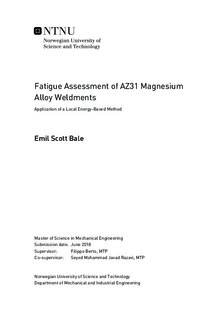Fatigue Assessment of AZ31 Magnesium Alloy Weldments - Application of a Local Energy-Based Method
Master thesis
Permanent lenke
http://hdl.handle.net/11250/2561555Utgivelsesdato
2018Metadata
Vis full innførselSamlinger
Sammendrag
Traditional stress-based fatigue criterions are highly dependent of geometry and loadingmode and are often based on idealized geometries and loading conditions. These fatiguecriteria are seldom applicable in general engineering assessments of structural components.
The scope of the thesis is therefore to apply the energy-based fatigue criterion of averagelocal strain energy density (ASED) to welded joints of AZ31 magnesium alloy. Afatigue criterion which is both geometry and loading mode independent. The applicationof ASED as a new criterion was based on experimentally gathered fatigue data for threedifferent weld geometries, namely: fully penetrated butt welded plate; non-penetrated buttwelded plate; plate with a welded transverse stiffener. These three geometries were subjectedto three different loading ratios of R=-1, R=0, and R=0.5.
Application of ASED criterion was performed with the aid of a numerical investigation usingthe Computer Aided Engineering (CAE) software Abaqus 6-14. Finite element modelswere constructed to best represent the actual occurring constraints, which were applied tothe experimental specimens during testing. The models were then subjected to the stressrange (∆σ) used experimentally.
The control radius (Rc) which defines the in-closed volume used in the fatigue evaluation,was found with the aid of a "best-fit" approach. Fatigue data from the three geometriesunder R=0 loading were tested with incrementally changing Rc. The Rc that yieldedthe best regression fit was select to be the appropriate one, resulting in the selection ofRc = 0.15 mm.
In addition to the numerical investigation, an analytical evaluation of ASED was preformedto compare the results with the FEM results. Through this evaluation it was foundthat the discrepancy between calculating ASED from the stress intensity factor (SIF, which is found through fine mesh FEM) and the extracted ASED was at 11.8%. It is important to mention that SIF was extracted by using ∼1500 elements, and ASED with 40, whichgives a ratio of 1:37.5.
